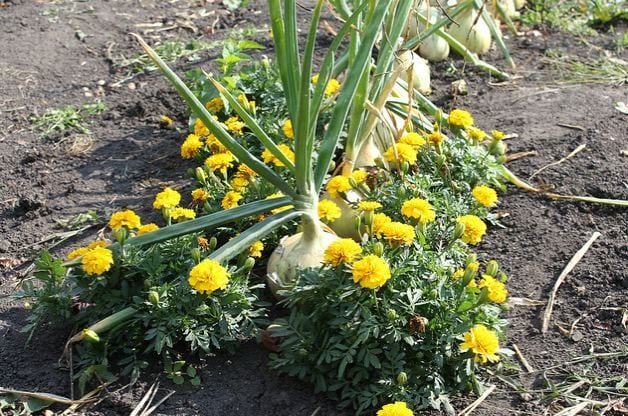The Essential Guide to Companion Gardening
Updated: Jan. 03, 2024

Some flower and vegetable plants work best when planted together. Here's everything you need to know about companion gardening.
Having a beautiful, healthy garden is a goal that many of us work hard to achieve. But did you know that certain plants are able to do much of the work for you?
It’s called companion gardening, and people have been practicing it for centuries. It’s simple, really—companion plants have qualities that benefit other plants. Not all horticulturalists are going to agree with these backyard home remedies, but many gardeners have used them for years to repel damaging insects, add nutrients to the soil, improve the growth of vegetables and prevent plant disease. Is it worth a try? You decide.
The practice of pairing plants isn’t new. Native Americans used the “three sisters” method, growing beans, corn and squash together. The corn provided support for the beans, the squash shaded the soil and kept weeds down, and the beans replenished the soil with nitrogen at the end of the season. Now that’s a mutually beneficial relationship!
When it comes to companion plants, some pairings aren’t always obvious. For example, who would think that strawberries would love being planted next to onions, or that roses enjoy being surrounded by garlic? Yet both combinations work well.
Natural Insect Repellent
Using plants with insect-repelling qualities is an easy way to decrease the use of insecticides and still reduce insect damage. The scents of basil, catnip, garlic, marigold, and petunia repel some damaging insects without harming beneficial ones. There’s still a debate among scientists, and results may vary from one garden to the next, but you may want to give it a try. You’ve got nothing to lose and some possible benefits to gain.
Another way to keep damaging insects away from your garden is to trick them by masking the other plants’ scents. You can easily do this by mixing fragrant herbs like basil, chives, oregano, rosemary and sage in with your other plants. Because the strong-smelling herbs mask the scents of desirable plants, damaging insects often will leave them alone.
Certain plants act as magnets for bad bugs. Geraniums, lantana, petunias and nasturtiums are irresistible to many insects. For instance, whiteflies love lantana, and aphids can’t resist nasturtiums, so those pests may focus on their favorites, rather than feasting on your other plants. This method is definitely worth a shot. Try interspersing these magnet plants throughout your garden and see if that does the trick, but it’s not a guaranteed magic solution. Keep monitoring your plants and address the problem early.
Good Bugs and No-Fuss Fertilizer
Next, consider plants that will attract more good bugs. Since they naturally help keep bad bugs away from your garden, they’re a perfect fit for companion gardening. Flowering plants such as alyssum, bachelor’s button, bee balm and cosmos not only lure helpful insects that will prey upon damaging insects, but also attract pollinators such as bees.
One of the easiest ways to draw in beneficial insects is to include plants with the bell-shaped flowers that often appeal to them. Foxglove, Canterbury bells and campanula are all good options. Plants in the dill family will also bring in good bugs that will eat pests. As a bonus, dill is also a host for swallowtails.
With companion planting, you can save money on fertilizer, too. Most plants enjoy enriched, fertile soil. But instead of adding fertilizer, why not let plants do the work for you?
Alfalfa, beans, beets, clover and kohlrabi all add nutrients to the soil when they die at the end of their growing season. Alfalfa, beans and clover take nitrogen from the air and convert it into a form of nitrogen that the plants can absorb in the soil. Beets and kohlrabi naturally add vital minerals to the soil.
Benefits to Veggies
Many gardeners believe complementary plants in the vegetable garden can boost growth and flavor because they secrete substances into the soil that help other vegetables. To improve the flavor of your tomatoes, for example, plant basil alongside them. Or try planting chamomile with cabbage, cucumbers or onions to improve their flavor and make them grow faster.
In addition to repelling damaging insects, herbs such as basil, garlic, mint, sage and thyme help reduce the incidence of disease in your garden. Onions provide similar benefits, and they also prevent mold on strawberries.
Tall Plants with Benefits
Another easy form of companion gardening is simply to use tall plants. They provide shade to sun-sensitive plants, and also act as a windbreak. Sunflowers planted next to your vegetable garden, for example, can protect cucumbers and tomatoes from the searing afternoon sun.
With all the benefits that companion plants offer your garden, why would you spend extra time spraying for pests and fertilizing? Just choose the right pairings and I believe you could enjoy a thriving natural garden full of bigger, tastier, healthier plants—with minimal effort.
Common Beliefs About Companion Plants
- Alyssum – Attracts helpful insects and pollinators
- Basil – Repels flies
- Beans – Add nitrogen to soil
- Beets – Add minerals to soil
- Borage – Improves growth, flavor and disease resistance
- Chamomile – Attracts beneficial insects; improves flavor and growth
- Chives – Repel damaging insects; improve flavor and disease resistance
- Garlic – Repels damaging bugs; improves disease resistance
- Marigolds – Repel nematodes and whiteflies
- Onions – Repel damaging insects; improve flavor of strawberries